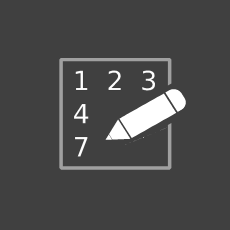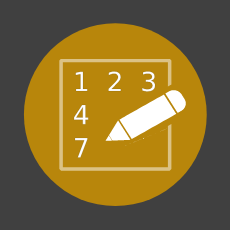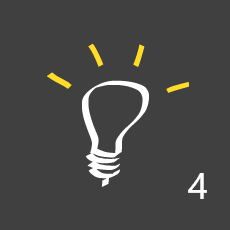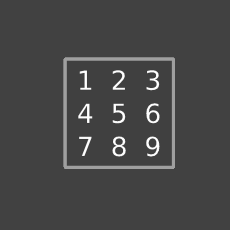A Sudoku consists of 9 rows, 9 columns and 9 boxes. In each of these units, all digits from 1 to 9 must be inserted exactly once.


Solving the free cells is done either directly via the large digits or first via small candidates with which possible digits can be preselected.
Useful in candidate mode
- Touching unresolved cells (candidates)
- If multiple cells are swept, then multiple candidates can be set or removed at the same time.
- A long touch sets the currently selected candidate as a large solved digit. Exception: if the current cell contains only one candidate left, the long touch sets this candidate as a large solved digit.
- Touching solved cells (large digits)
- Switches the current candidate to the solved digit or marks its forbidden regions in red.

Before starting a new game or a training game, one of the 11 difficulty levels or one of the 40 strategies can be selected.
Separate statistics are kept for both types of games with the number of games, best times and average times.

During the game, there are four help levels:
- Only the difficulty level of the next easiest strategy is displayed.
- The name of the required strategy is displayed.
- The correct solution digits are set in the control field. It may happen that several candidates are selected at the same time.
- In addition, the correct solution cells are highlighted in green. For single digits, it is sufficient to tap the highlighted cell. Otherwise, the set candidates can be removed by swiping over the region. The highlighted cells can be safely swept as well. For hidden pairs, triples or quads, the candidates are thereby removed from the highlighted cells, otherwise from all other swept cells.
In addition to these help levels, there is an explaining step-by-step help. It can be switched on at any time in the normal game or in a training game and serves excellently as a guide.
To solve or end the help prematurely, all you need to do is make a change to the Sudoku board – for example, entering the solution in the same manner as in the last help level, even if the control field is not visible when you do so.
From the third difficulty level on, single digits can be solved automatically. Before this it makes no sense, because the simpler Sudokus can be solved exclusively with single digits.

In principle, the possible candidates can be calculated automatically. However, Sudokus with the difficulty levels 1 and 2 can still be solved without the use of candidates.

It is always possible to share the starting arrangement of the current game or training game in order to face the same challenges together or to be able to play the same game again later. It doesn’t matter whether the game has just been started or has already been completely solved.
Alternatively, you can share the progress of a started game – for example, to puzzle together.
Logic for Sudoku beginners
In each row, column and box, i.e. in each unit of a solved Sudoku, each digit from 1 to 9 occurs exactly once. Thus, if a particular digit already occurs in one unit, it cannot occur again in the same unit. If in all three units of a cell the digit does not occur yet, then it is a candidate for this cell and can be entered with a small digit. Tip: A certain candidate can also be entered for several cells at the same time in the game.
If the candidates are entered correctly and completely, then there may be special relationships between two cells:
- In a unit, there are at least two identical candidates. This is called a weak link and the link is shown in the guide by a dashed line. If one of the candidates is true, it follows that the other is false.
- In a unit, there are exactly two identical candidates. This is called a strong link, and the link is represented in the guide by a solid line. If one of the candidates is false, it follows that the other is true.
- On the other hand, if there is only exactly one candidate left in a unit, then that candidate is always true.
For more difficult games, such links can be used to form chains that span many units.
Difficulty levels and strategies
The difficulty levels ≥ 6 are only available in the full version of Sudoku Logica.
| # | Difficulty level | Strategy | |
|---|---|---|---|
| 1 | 1 | Very simple | Last Digit |
| 2 | Hidden Single (Box) | ||
| 3 | 2 | Simple | Hidden Single |
| 4 | Naked Single | ||
| 5 | 3 | Medium | Pointing Candidates |
| 6 | Naked Pair | ||
| 7 | 4 | Challenging | Claiming Candidates |
| 8 | Hidden Pair | ||
| 9 | Naked Triple | ||
| 10 | X-Wing | ||
| 11 | 5 | Tricky | Naked Quad |
| 12 | Swordfish | ||
| 13 | Simple Coloring (4 cells) | ||
| 14 | XY-Wing | ||
| 15 | 6 | Bewitched | Hidden Triple |
| 16 | Jellyfish | ||
| 17 | Finned X-Wing | ||
| 18 | Simple Coloring (6 cells) | ||
| 19 | XYZ-Wing | ||
| 20 | W-Wing | ||
| 21 | X-Chain (4 cells) | ||
| 22 | 7 | Hard | Hidden Quad |
| 23 | Finned Swordfish | ||
| 24 | Simple Coloring (8 cells) | ||
| 25 | W-Chain (6 cells) | ||
| 26 | X-Chain (6 cells) | ||
| 27 | XY-Chain (4 cells) | ||
| 28 | 8 | Very hard | Finned Jellyfish |
| 29 | Simple Coloring (10+ cells) | ||
| 30 | W-Chain (8+ cells) | ||
| 31 | X-Chain (8+ cells) | ||
| 32 | XY-Chain (5+ cells) | ||
| 33 | 9 | Extreme hard | Unique Rectangle |
| 34 | Hidden Rectangle | ||
| 35 | Incomplete Rectangle | ||
| 36 | Advanced Coloring (5 links) | ||
| 37 | Alternating Chain (5 links) | ||
| 38 | 10 | Ultra hard | Advanced Coloring (7+ links) |
| 39 | Alternating Chain (7+ links) | ||
| 40 | 11 | Unsolvable | Trial and Error |
Additional information for the full version
For each difficulty level, the database contains 10,000 Sudoku puzzles, all of which can be solved uniquely using the strategies of each difficulty level. By permutations of digits and regions, Sudoku Logica thus randomly selects from about 1017 starting arrangements.